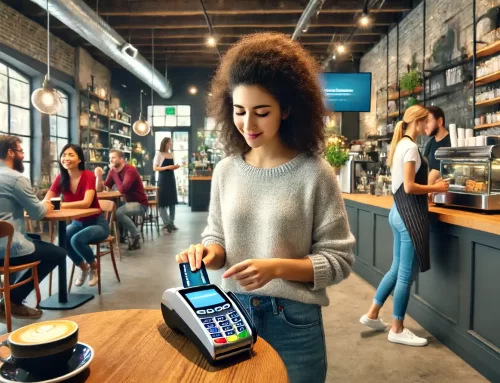Contactless Payment Processing
Contactless payments are made by tapping or waving a contactless device, like a credit card, debit card, smartphone, or watch, over a scanner, which takes the payment. It lets you pay quickly without entering your PIN (personal identification number).
It’s possible to make contactless payments using a bank card, a mobile phone, or other contactless devices. Banks and retailers also call this “Tap-and-pay”.
Contactless Payment Processing Explained
The term “contactless payment” refers to a secure transaction method that allows customers to pay for goods and services using their smartphones, debit or credit cards. Smart devices or cards send payment info using radio frequency identification (RFID) and near-field communication (NFC) technologies. This allows customers to pay for goods and services without physically swiping their cards. Smartphone apps and mobile wallets have increased the popularity of contactless purchases.
How Contactless Payment Processing Works
Consumers may pay for products and services by swiping their debit or credit cards equipped with a sort of RFID technology (chip cards). With this technology, the customer doesn’t need to use their personal identification number (PIN) or swipe and sign to make a purchase. Contactless payment methods, including those that display the wave sign, will be available at retailers who accept it.
When the point-of-sale (POS) system at the shop asks for payment, consumers who want to utilize contactless payment must bring their card to the machine’s contactless payment symbol. Customers’ banks will be able to access their account information through the chip on their card. If the POS device acknowledges the payment, customer notification options include a buzzer, checkmark, or green light. Once the system gets approval, the transaction is considered to be done.
Customers may also use their mobile device or wristwatch to link their credit or debit cards. A user must first download a payment app capable of securely saving their credit card information and then touch their smartphone to authenticate their identity before they can make a transaction on the website.
Contactless Payment Processing Technology
Customers can make payments without touching anything with RFID-enabled cards or e-wallets, also called mobile wallets, installed on their phones. Their bank or card issuer may put limits on both types of transactions, and these limits may be different depending on the financial institution. Even though many stores still allow significant transactions, they may also set boundaries to prevent fraud. A signature might also be needed to make the transaction official for some payments over a certain amount. Some Apple Pay users in the US might have to sign for purchases over $50.
Contactless Cards
Contactless payment systems, like cards, use NFC, a type of technology that is part of RFID. NFC only works when there is a short distance between the card or other device and the POS terminal. The idea behind this rule is to ensure your card or device won’t pay for someone else’s transaction by accident.
Customers can also get cash from contactless ATMs by tapping their card on the machine instead of swiping it and entering their PIN.
E-wallets
E-wallets, often known as mobile wallets, are smartphone apps that make use of NFC technology. To make contactless payments using a smartphone, smartwatch, or other wearable device, consumers must first install an app, such as Apple Pay or Google Pay, and then link their credit cards to those accounts.
Users may also link their debit cards to these devices to withdraw cash from ATMs. Although most large banks need their proprietary software to use cardless ATMs, certain institutions’ cards are compatible with a number of e-wallets.
Where Can You Use Contactless Payments?
The vast majority of retail establishments in the United States allow customers to experiment with contactless payment methods. Contactless payments, such as mobile wallets, are often announced at the entrance of a store. Customers may look for a Wi-Fi-like icon to see whether a business has NFC-enabled payment terminals.
Contactless technology has already been included into chip cards by most major U.S. card issuers; however, customers with cards that do not yet have the technology may still utilize mobile wallets.
Advantages of Contactless Payment Processing
Using magnetic strips to transfer information is less safe than using contactless payment methods. Magnetic strips include information that thieves may copy, while NFC technology transmits data in an encrypted form, making it more challenging to steal.
It is more hygienic and convenient to avoid exchanging cash or credit cards when paying for products or services. The COVID-19 pandemic in 2020 is one reason why contactless transactions have become considerably more common. Contactless payments are faster; taking approximately half the time than chip cards, therefore making them easier to accept. Customers have the ability to challenge any fraudulent transactions and obtain new cards in the event that their information is taken.
Contactless payments are gaining popularity, therefore, companies need to find ways to accept them in order to satisfy consumers. The technology necessary for businesses to implement contactless payments is available right now. Businesses should do it immediately before customers begin to reject places that do not provide contactless payment options.




